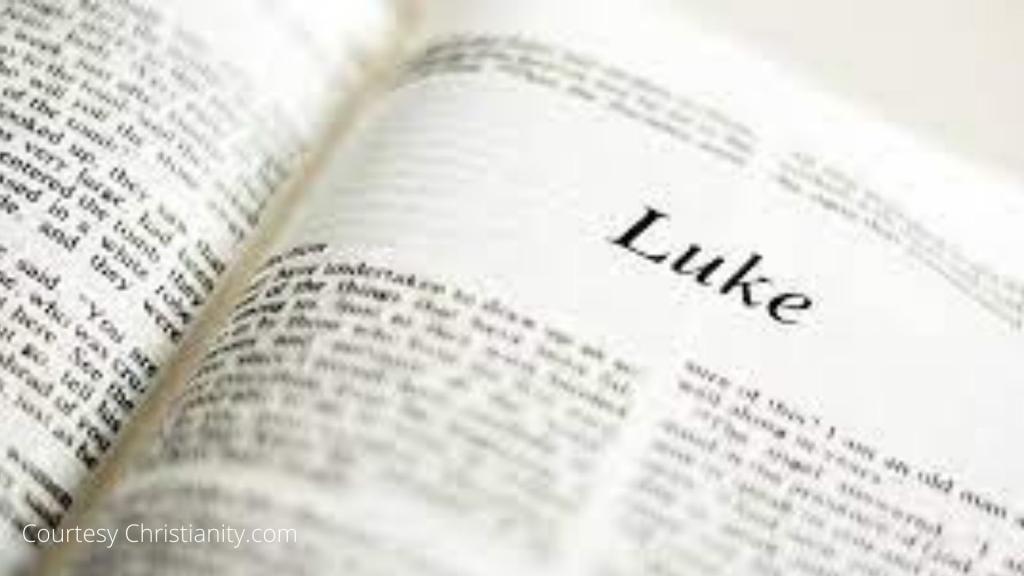
A devotional guide to the Gospel of Luke[1]
Monday: Read: Luke 1:1-4; 1 Sam 1:1-2:11
If you are able to do so: watch the Bible project video on Luke 1-9:
We begin the Gospel of Luke with a reading of 1 Sam 1:1-2:11 in order to prepare us for the story of the births of John the Baptist and Jesus which we will investigate in tomorrow’s reading.
Luke 1:1-4 serves as a preface for the Gospel of Luke (Although we have not invested much effort in discerning the author, recipients, or the date of the writing for Matthew and Mark, recognizing the recipient of the Gospel of Luke will help to intensify the significance of Luke’s account of the life of Jesus. Luke addresses “most excellent Theophilus” (1:3: ‘lover of God’). The address “most excellent” suggests that he is a member of the equestrian order in Roman society (‘knights’)—from which the members of the Roman senate derive. This makes Theophilus one of the very few who comprised the elite in Rome. Such persons do not work but live off the labor of others. Through taxation and loans, they come to acquire more and more lands at the expense of the landowners who cannot afford the excessive taxation nor to pay back their loans.
There are good reasons to conclude that Theophilus had become a Christian. We might speculate that he wanted to know more and thus he financed Luke’s work, which was written, “so that you may know the exact truth about the things you have been taught” (1:4).
Luke seems to emphasize in this preface that there were ‘many’ stories of Jesus floating around and he wrote after carefully investigating everything (1:3). Luke adds that his careful investigation included “eyewitnesses” (1:3).
There is little doubt that Luke used the Gospel of Mark as a source. Many scholars believe that he also met Mary and some of the early Christians.
Questions to ponder/discuss:
- As far as we can tell, Luke was not an eyewitness of Jesus. Based on Luke 1:1-4, what do you think of Luke’s ability to write his version of the Jesus story?
Tuesday: Read Luke 1:5-45
Although today’s reading is probably familiar to many of you, try to get that familiarity out of your mind.
Luke narrates the births of John the Baptist and Jesus. But he does this by echoing the story of Samuel. The stories of Elizabeth and Zechariah (1:5-25, 39-45, 57-80) remind us of the story of Hannah and Elkanah in 1st Samuel (1 Sam 1:1-2:11).
The significance of this is that 1st Samuel is about the establishment of Israel’s monarchy. Samuel was the prophet who anointed David the King. In making this connection with Samuel, Luke presents the story of Jesus in light of the establishment of a new Davidic kingdom. John the Baptist is the prophet who anoints Jesus the new king.
Both 1st Samuel and the Gospel of Luke begin as stories of judgment. Samuel announces to the priest Eli that his days and the days of his sons will come to an end. In the same way, John the Baptist proclaims God’s judgment with even more explicit warnings against both Israel and the Temple (3:1-17).
In narrating the infancy stories of Jesus in light of the coming of David, Luke presents Jesus as the new Davidic king who will reign forever. Jesus’ kingdom is an alternative kingdom. It is this fact that even the followers of Jesus will have trouble grasping. The key, as we will see, is that the Kingdom of God is based on things that last into the new creation.
Questions to ponder/discuss:
- One of the key themes in the Gospel of Luke is the present working of the Holy Spirit (remember, Luke also wrote Acts). As you read through the Gospel of Luke, underline or highlight every time you see the Holy Spirit. If you have already completed today’s reading note the Holy Spirit appears in 1:15, 25, 41.
- Why do you think the angel told Mary about Elizabeth’s pregnancy and why do you suppose Mary went to visit her?
Wednesday: Read Luke 1:46-80
Mary’s song, often known as the Magnificat, is too often overlooked—especially among Protestants (note that Mary in the Bible is neither Catholic nor Protestant. She is Mary)—is very nationalistic (54). She thanks God because He has fulfilled His promises to Abraham (55). Throughout her song she praises God for His mercy (50) and that God favors the “humble” (48) and those who “fear Him” (50), and He “scatters the proud” (51). She adds that God fills “the hungry with good things,” and sends “the rich away empty” (53).
We may want to read this in light of our personal piety. But Mary likely means that God has come to restore Israel and destroy Rome. It is Rome’s insatiable appetite for more and its acquisition of wealth that has left everyone else destitute. Mary, along with the rest of the Israelites, had suffered under Roman oppression for years. Her gratitude that God will bring “down rulers from their thrones” (52) and He exalt “those who were humble” can only mean that she sees the end of Rome and the establishment of a new Davidic kingdom for Israel.
Zacharias’ song is similar. He notes that God has brought salvation (68, 69, 71, 77), but he perceives that it is for Israel (“the house of David”; 69). For Zacharias, this salvation is deliverance from “our enemies” (71).
This is not to say that they were wrong. They were simply stating the nature of the Kingdom as they understood it at the time. Little did they know that Jesus’ kingdom will rule the whole world and that it includes the nations.
This is why the disciples and many others had trouble understanding the teachings of Jesus. Surely, He was the promised One, but why does it not appear to be so? Even John the Baptist begins to wonder if Jesus is the Christ (7:18-20).
They will not understand completely until Pentecost (and that doesn’t happen until Acts 2). Even the resurrected Jesus doesn’t make sense to the couple on the road to Emmaus (24:13-35).
Questions to ponder/discuss:
- The Gospels are a great reminder that the kingdom that Jesus inaugurated was radically different than what they were expecting. Write down as many things as you can regarding what you presently believe the kingdom of God is about: (e.g., you might say, “it brings us salvation” and “hope”).
- Then, as we continue in our study, make a list of what the kingdom looks like according to Luke. At the end of our study compare the lists
- If the Gospel and the kingdom were radically different than what Mary, John the Baptist, and the disciples were expecting, might we too have conceived of the kingdom in ways that do not accurately reflect the kingdom?
Thursday: Read Luke 2:1-20
Joseph and Mary travel from Nazareth to Bethlehem because Caesar decrees that a census be taken. A Roman census was another display of imperial power. Empires count people so that they can tax them. The money ensures that Rome’s elites can maintain their extravagant lifestyle while the rest struggle for their daily needs. Joseph and Mary’s venture to Bethlehem would have added to their hardship. The journey would have been very inconvenient. Such a trip was normally a 3-day journey—though Mary’s pregnancy may have hampered them some.
The notion that Jesus was born in a barn does not fit the text well. They most certainly had taken up residence in someone’s home—likely a relative’s. The home may well have been built up against the entrance to a cave where the animals stayed during the winter months. Thus, Jesus was laid in a feeding trough (7).
The idea that her pregnancy was shameful and that no one would have taken them into their home is highly unlikely. Hospitality was required in this culture; especially since Mary was pregnant. Once those in Bethlehem learned that Joseph was a descendant of David, there is little doubt that anyone would have provided a place for them to stay.
NB: Ian Paul has written a wonderful blog on Jesus’ birth and why we are confident that Jesus was born in a house and not in a stable.
Questions to ponder/discuss:
- The modern version of the Jesus story has Him detached from even the people of Bethlehem. The textual evidence is fairly conclusive: Jesus was born among the people: probably in a one-room house. It makes more sense to suppose that Jesus was born among us and not detached from us. Just as Jesus lived among the people. He was not hidden in a cave. Jesus came to dwell among the people. Do you hide Jesus from others or do you attempt to live out your faith in the midst of the people? When people come to know you are they surprised that you are a Christian?
- What do you suspect that Luke means when he says that Jesus is a “sign to be opposed” (34).
Friday: Read Luke 2:21-52
The stories of Simeon (25-32) and Anna (36-38) are meant to compare and contrast with each other. Together they represent two witnesses. As a man and a woman, they may serve to represent all Israel. Note: Simeon is the name of one of the southern tribes (25). Anna was from Asher (one of the northern tribes). Simeon was “looking for the consolation of Israel” (25); while Anna was ‘looking for the redemption of Israel’ (38).
Simeon’s song of praise parallels Zacharias’ song: Jesus has brought salvation (30). Simeon even seems to understand that Jesus’ kingdom is one for “all peoples” (31) and is a “light of revelation to the Gentiles” (32).
Anna, like Simeon (25-27), is portrayed as a woman of great character (36-37). That she lived with her husband for 7 years (36) and now is 84 (37: this could mean that she was widowed for 84 years). The numbers have to be important or why else would Luke have mentioned them? (84 = 7 x 12). This may mean that the time for “the redemption of Jerusalem” (38), which she was waiting for, has come. That is, the time has been fulfilled (thus, “7”) for the people of God (thus, “12”).
Mary learns from Simeon that Jesus “will cause the rise and fall of many in Israel” (34; cf 20:17-18; Isa 8:14-15; 28:13-16; Rom 9:33; 1 Pet 2:6-8).
Luke tells these two stories because they present important themes that he will build on as the gospel progresses: the time has come; the promises have been fulfilled; the nations are included.
The chapter closes with the story of Jesus being left behind at the temple. The result is that Mary and Joseph are continuing to learn who Jesus really is. Did they not know that Jesus “had to be in My Father’s house?” (49).
Questions to ponder/discuss:
- What do you see are some of the significances of the stories of Simeon and Anna? Why would Luke include these stories?
NB: My goal is to keep these posts free of charge. I do not intend to ever hide them behind a paywall. I can only do this if those of you who have been blessed by them and can afford to give ($5, $10, $25, or more/month) do so. You can give a tax-deductible contribution by following this link.
Please share this post and let others know about determinetruth.
If you wish to view this blog on your smartphone through the Determinetruth app simply download the “tithe.ly church” app on your smartphone and insert “determinetruth” as the church name you wish to follow. Once it is loaded, simply click on the “blog” icon and they will automatically load.
If you would like to have Rob speak at your church or organization in person or via zoom, please let us know by filling out the contact info on the Contact me tab on this site.
[1] This guide is meant to be done either as a group study over the course of 4-6 meetings (Day 1-5; 6-10; 11-15; 16-20, etc), or as a private devotion over the course of 4 weeks (or a calendar month—5 lessons per week).












